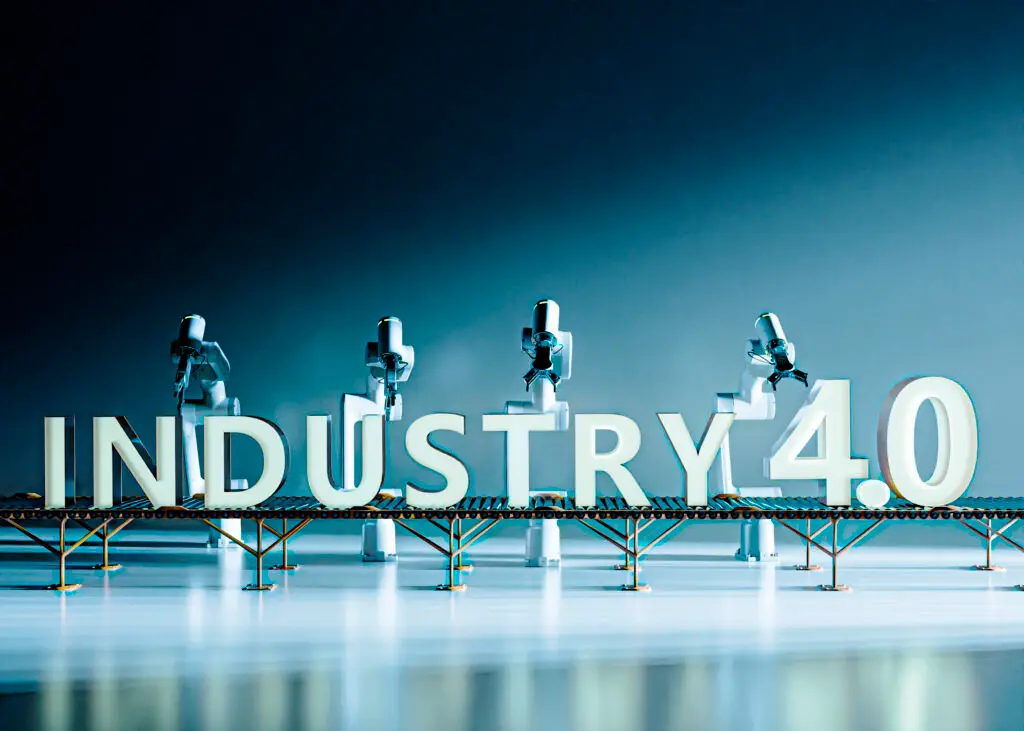“Industry 4.0: The Revolution of Smart Manufacturing | Benefits, Examples & Challenges – MECHSTECH”

Table of Contents

Industry 4.0: Embracing the Fourth Industrial Revolution
Introduction: Understanding Industry 4.0 and Its Importance
Hello Friends, by the end of this season, you will have a profound understanding of Industry 4.0 and its significant impact on the manufacturing sector. Let’s explore the key topics we will cover:
1. What is Industry 4.0, and why is it crucial for the future?
2. The key technologies driving Industry 4.0 (IoT, AI, Robotics, Big Data).
3. The benefits of implementing Industry 4.0 in manufacturing.
4. Real-life examples of Industry 4.0 in action.
5. The challenges and potential risks of implementing Industry 4.0.
6. A practical guide to starting Industry 4.0 in small and medium-sized businesses.
Industry 4.0: A Revolutionary Leap in Manufacturing
Industry 4.0 is the Fourth Industrial Revolution, marking a remarkable shift in the history of industries. Let’s take a journey through time, starting from the first Industrial Revolution with the advent of steam engines and mechanization, to the second Industrial Revolution with electricity leading to mass production. The third Industrial Revolution brought computers and the digital revolution. And now, in the 1960s and beyond, the Fourth Industrial Revolution has emerged, incorporating diverse sensors, advanced connectivity, artificial intelligence, machine learning, CPS, M2M communication, and other groundbreaking technologies. The aim of this revolution is to transform industries, giving rise to smart factories, intelligent inventory management systems, and advanced supply chain management. Industry 4.0 represents a significant milestone in leveraging cutting-edge technologies to enhance industrial processes and operations.
Understanding the Aims of Industry 4.0
The core objective of Industry 4.0 is to revolutionize manufacturing processes by creating a connected network of machine devices and sensors. This interconnected ecosystem facilitates real-time data exchange, empowering machines to make decisions based on up-to-date information.
The Key Technologies Driving Industry 4.0
Industry 4.0 is shaped by five key technologies:
1. IoT (Internet of Things):-
A network of connected devices, sensors, and machines that collect and exchange data, monitoring machine performance, tracking inventory, and optimizing production processes.
2. AI (Artificial Intelligence):-
The amalgamation of machine learning and deep learning empowers manufacturers to analyze vast datasets in real-time, enabling prompt and well-informed decisions, driving efficiency and effectiveness in operations.
3. Robotics:-
Revolutionizing manufacturing by handling repetitive or dangerous tasks, freeing humans to focus on complex or creative work.
4. Cloud Computing:-
Utilizing it as a secure repository for data and information, this system efficiently stores the vast amounts of data produced by machines, sensors, and various devices throughout the manufacturing process.
5. Big Data Analytics:-
Its capacity to handle the massive data influx ensures seamless data storage and management, facilitating smooth operations and data-driven insights for the manufacturing industry. For instance, Suzlon Energy leverages predictive maintenance techniques to continuously monitor their wind turbines, ensuring proactive maintenance and optimized turbine performance for reliable and efficient energy generation.
The Remarkable Benefits of Implementing Industry 4.0 in Manufacturing
Industry 4.0 offers numerous advantages:
1. Improved efficiency through AI and machine learning, automating many manufacturing processes.
2. Enhanced quality with real-time sensor data for prompt defect identification.
3. Increased flexibility through robotics and automation, streamlining production.
4. Better data management, utilizing large datasets to optimize manufacturing processes.
5. Improved safety and cost-saving by enhancing efficiency, reducing waste, and optimizing resource utilization.
Real-Life Examples of Industry 4.0 in Action
Several industries showcase Industry 4.0 applications:
1. Predictive Maintenance:-
Suzlon Energy employs sensors and data for predictive maintenance of wind turbines, ensuring timely repairs and optimized performance.
2. Digital Twins:-
G.E. utilizes digital twins to closely monitor and optimize jet engine performance, enabling real-time analysis and predictive insights.
3. Augmented Reality:-
Blue Dart enhances warehouse operations by utilizing augmented reality headsets to assist workers, minimizing errors and enhancing overall efficiency.
Moreover, smart factories exemplify fully automated enterprises that leverage connected devices and sensors to optimize production processes. An illustration of this concept can be seen in Festo Pneumatic, which operates a plant in Esslingen am Neckar, Germany, incorporating advanced technologies to streamline manufacturing operations and improve productivity.
Addressing the Challenges and Potential Risks of Industry 4.0 Implementation
Implementing Industry 4.0 poses challenges and potential risks:
1. Cultural Challenges:-
Organizations may encounter obstacles due to resistance to change, hindering the smooth adoption of Industry 4.0 initiatives.
2. Business Model Challenges:-
Concerns about the costs and return-on-investment of Industry 4.0 initiatives may require careful funding decisions.
3. Technology Challenges:-
Addressing aspects like IT and OT infrastructure separation, data transmission protocols, and cybersecurity protection.
But despite challenges, industries remain positive about the potential of Industry 4.0 initiatives, indicating a firm embrace of the idea.
How to Get Started with Industry 4.0 Implementation in Small and Medium-Sized Businesses
To optimize manufacturing processes, implement Internet of Things (IoT) solutions with smart connectivity. Advantech’s WebAccess/HMI platform is an example, enabling remote monitoring and control.
For legacy equipment monitoring, utilize solution-ready platforms (SRPs) like Advantech’s iFactory SRPs. These quick-start tools facilitate a modular approach with flexible functionality, connecting devices and systems for streamlined operations.
Stay Connected With Us at MECHSTECH as We Embrace the Future of Manufacturing!
Stay Connected With Us and Be Prepared With MECHSTECH for insightful content on various topics:
1. Types of Cutting Tool Materials
https://www.mechstech.com/2021/07/types-of-cutting-tool-materials.html
2. Tool Wear, Tool Life & Machinability
https://www.mechstech.com/2021/07/tool-wear-tool-life-machinability.html
3. Parts of Lathe Machine
https://www.mechstech.com/2021/06/parts-of-lathe-machine.html
4. Various Operations Possible on the Lathe Machine
https://www.mechstech.com/2021/06/various-operations-possible-on-lathe.html
5. Research Paper: Fire Extinguisher Drone
https://www.mechstech.com/2021/01/reserch-paper-fire-extinguisher-drone.html
Image Credit Goes To Forbes
Thank you for joining us on this exciting journey!

hii
Pingback: Exploring Process Automation Companies for Efficiency